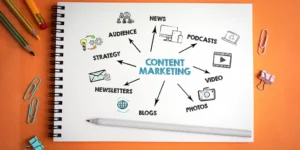In the fast-evolving digital landscape, content marketing trends constantly shift, driven by changes in technology, consumer behavior, and platform innovations. Staying ahead of these trends is essential for marketers aiming to capture attention, build brand loyalty, and drive results. As 2024 approaches, certain strategies are emerging as go-to methods, while others are losing their appeal.
Here’s a look at the current content marketing trends—what’s hot and what’s not—to help you keep your marketing approach relevant and impactful.
What’s Hot in Content Marketing?
1. AI-Driven Content Creation and Personalization
Artificial intelligence (AI) is redefining content marketing, enhancing efficiency, and enabling highly personalized experiences. Tools like ChatGPT and Jasper are assisting marketers in generating content ideas, drafting, and optimizing for SEO. AI allows for better audience segmentation, helping to deliver customized content that resonates with individual users based on their preferences and behaviors.
- Why It’s Hot: AI-driven content not only streamlines content creation but also improves user engagement by making content more relevant.
- Tip: Use AI to analyze data on your audience, develop topic clusters, or create outlines, but maintain a human touch for creativity and empathy.
2. Video and Interactive Content
Short-form videos, especially those under 60 seconds on platforms like TikTok, Instagram Reels, and YouTube Shorts, are captivating audiences like never before. Interactive content, like quizzes, polls, and augmented reality (AR) experiences, allows users to actively engage, which increases retention and shares.
- Why It’s Hot: Video content is memorable and shareable, and interactive content offers a personalized experience that deepens engagement.
- Tip: Repurpose long-form video content into shorter clips for social media and consider adding interactive elements like live polls during events.
3. Voice Search Optimization
With the rise of smart speakers and voice assistants, optimizing for voice search is crucial. Voice search queries are typically more conversational, meaning content should be adapted to answer questions naturally and directly.
- Why It’s Hot: Nearly 50% of consumers use voice for online searches, making it a valuable channel to enhance visibility.
- Tip: Focus on creating content that directly answers questions and includes long-tail keywords to capture voice search traffic.
4. Ephemeral Content
Content with a short lifespan, like Instagram Stories, Snapchat Snaps, and LinkedIn Stories, is gaining traction as it creates urgency and exclusive engagement. Ephemeral content is particularly appealing to younger audiences who value authenticity and real-time experiences.
- Why It’s Hot: These short-lived formats are quick, real, and highly engaging. They give brands a chance to connect more informally.
- Tip: Use ephemeral content to showcase behind-the-scenes moments, limited-time offers, or quick updates to keep followers engaged.
5. User-Generated Content (UGC)
UGC continues to be a top trend as brands leverage customer content—reviews, testimonials, and photos shared by users—to build credibility. UGC builds a sense of community and authenticity and often resonates more strongly with audiences than branded content.
- Why It’s Hot: Consumers trust real people more than ads. UGC provides social proof, enhances brand loyalty, and encourages engagement.
- Tip: Encourage your audience to share their experiences with your brand by creating branded hashtags or hosting contests.
What’s Not So Hot Anymore?
1. Overly Polished, Perfect Content
Gone are the days when everything needed to look pristine and professionally produced. Today, audiences crave authenticity and relatability, and overly polished content can come across as impersonal. Brands that show the human side of their business—flaws and all—are resonating better with users.
- Why It’s Not: Overly curated content feels disconnected from reality and may discourage user engagement.
- Tip: Consider showing raw, behind-the-scenes content and highlight the people behind the brand to create a genuine connection.
2. Generic Blog Posts
With the saturation of content online, generic blog posts that lack unique insights or perspectives are quickly losing their effectiveness. Content that simply covers basics or lacks depth does little to engage or educate the reader.
- Why It’s Not: The modern reader expects well-researched, in-depth information that adds value, not content designed to only meet SEO criteria.
- Tip: Focus on quality over quantity. Research topics deeply, offer unique insights, and aim to provide actionable advice in your blog posts.
3. Clickbait Titles
While catchy titles might have initially driven clicks, audiences have grown wary of clickbait as it often leads to disappointing or irrelevant content. Today, readers expect honesty and transparency, and clickbait can damage a brand’s reputation.
- Why It’s Not: Deceptive titles create a negative user experience, often leading to high bounce rates and a loss of credibility.
- Tip: Create titles that reflect the actual value and topic of your content. Use curiosity but keep promises realistic.
4. Over-Optimization for SEO
Stuffing content with keywords or over-optimizing for SEO no longer ranks well with Google. The focus has shifted towards a more human-centered approach, where content quality and relevance are prioritized over keyword density.
- Why It’s Not: SEO algorithms are now sophisticated enough to penalize content that sacrifices readability for optimization.
- Tip: Prioritize user experience by writing naturally, using relevant keywords strategically, and focusing on valuable information that engages readers.
5. Static, Non-Diversified Content Formats
Relying solely on text-based content or single-format posts is no longer enough. Audiences expect a diverse range of content formats, from infographics to podcasts and live-streamed events.
- Why It’s Not: Different audience segments consume content differently; limiting yourself to one format can alienate parts of your audience.
- Tip: Repurpose content into different formats to reach a broader audience, such as turning a blog post into a podcast episode or infographic.
Final Thoughts
As we move forward, the content marketing landscape will continue to evolve, driven by audience expectations, technological advancements, and platform developments. Staying updated on what’s trending and adapting to new methods will be key to engaging audiences effectively. Embracing authenticity, leveraging AI and interactive formats, and focusing on user-generated and value-driven content can elevate your brand’s content strategy.
Remember, content marketing is about creating a genuine connection with your audience. By understanding what’s hot and avoiding outdated practices, you can craft a strategy that not only meets your marketing goals but also adds value to your audience’s experience.
To know more about Digital Marketing, Please visit https://paypercampaign.com





